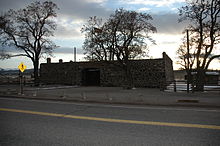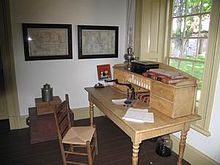- Cove Fort
-
Cove Fort is a fort and historical site located in Millard County, Utah. It was founded in 1867 by Ira Hinckley (the paternal grandfather of Gordon B. Hinckley) at the request of Brigham Young. One of its distinctive features is the use of volcanic rock in the construction of the walls, rather than the wood used in many mid-19th century western forts. This difference in construction is the reason it is one of very few period forts still surviving.
Cove Fort is the closest named place to the western terminus of Interstate 70, resulting in Cove Fort being listed as a control city on freeway signs, even though the fort is historical and has no permanent population.
Contents
History
The site for Cove Fort was selected by Brigham Young because of its location approximately half way between Fillmore, then the capitol of the Utah Territory, and the nearest city, Beaver. It provided a way station for people traveling the Mormon Corridor. A town would have been constructed at the Cove Fort site, but the water supply was inadequate to support a sizable population. Another key factor in the selection of the site was the prior existence of a wooden-palisade fort, Willden Fort, which provided shelter and safety for the work crews who constructed Cove Fort.
The fort is a square, 100 feet (30 m) on each side. The walls are constructed of black volcanic rock and dark limestone, both quarried from the nearby mountains. The walls are eighteen feet high and four feet thick at the base, tapering to two feet thick at the top. The fort has two sets of large wooden doors at the east and west ends, originally filled with sand to stop arrows and bullets, and contains twelve interior rooms.
As a daily stop for two stagecoach lines as well as many other travelers, Cove Fort was heavily used for many years, often housing and feeding up to 75 people at a time. In addition to providing a place to rest, a blacksmith/farrier resided at the fort who shod horses and oxen, and also repaired wagon wheels. With its telegraph office and as a Pony Express stop, it also acted as a regional communications hub.
Restoration
In the early 1890s, The Church of Jesus Christ of Latter-day Saints determined that the fort was no longer required and leased it out, selling it outright after the turn of the 20th century. In 1989 the Hinckley family purchased the fort and donated it back to the church. The church restored the fort, transported Ira Hinckley's Coalville, Utah cabin to the site, constructed a visitor center, and reopened the fort as a historic site. The site provides free guided tours daily, starting from about 8 a.m. until one half-hour before sunset.
Transportation
See also: Interstate 70 in UtahThe first highway to traverse Cove Fort was the Arrowhead Trail, which connected Salt Lake City with Los Angeles. When the U.S. Highway system was formed, this route became became U.S. Route 91, and is today Interstate 15. When the Interstate Highway System was in the planning stages, planners noted that there was no direct connection between the central United States and southern California. The result to fill this gap was a new freeway that would be built west from Green River, Utah towards Cove Fort, along a path that previously was inaccessible via paved roads. Since that time Cove Fort has also served as the western terminus of Interstate 70.[1]
In 2004, the Federal Highway Administration was testing a new typeface, Clearview, designed to have improved readability at night with headlight illumination. One test sign was placed at Baltimore, Maryland – the eastern terminus of Interstate 70 – that listed Cove Fort as a control city with a distance of 2,200 miles (3,500 km). One employee stated with the number of queries the department received about Cove Fort, the test was a success.[1] The sign prompted a series of stories about Cove Fort to be published in the Baltimore area. Since that time there has been a small effort by people in both states to lobby the Utah Department of Transportation to reciprocate by placing a sign at Cove Fort listing the distance to Baltimore.[2]
Notes
- ^ a b Weingroff, Richard. "Ask the Rambler: Why Does I-70 End in Cove Fort, Utah?". U.S. Department of Transportation – Federal Highway Administration. http://www.fhwa.dot.gov/infrastructure/covefort.cfm. Retrieved 2009-06-07.
- ^ Hiaasen, Rob (2004-06-04). "Go West Young Man; Like Horace Greeley's Famed Advice, Curious Sign on I-70 Beckons Yonder". The Baltimore Sun.
References
- History of Millard County (Lesson for ... / Daughters of Utah Pioneers) by Lou Jean S Wiggins
- Amazing But True Mormon Stories by Joan Oviatt
- Great Ghost Towns of the West by Tom Till and Teresa Jordan
- Utah Byways: 65 of Utah's Best Backcountry Drives by Tony Huegel
- The People: Indians of the American Southwest by Stephen Trimble
- Quilts and Women of the Mormon Migrations by Mary Bywater Cross
- Exceptional Stories from the Lives of Early Apostles by Leon R. Hartshorn
- Nineteenth-Century Mormon Architecture and City Planning by C. Mark Hamilton
- Mormon Architecture by Joseph Weston
- Mormon History by Ronald W. Walker, David J. Whittaker, and James B. Allen
- A New Zion: The Story of the Latter-day Saints by Bill Harris
- "LDS Restoration Project Gives Breath of New Life to Utah's Old Cove Fort" By Brian Giles, Feb. 6, 1992, Deseret News
- "Newly Restored Cove Fort Will Be Dedicated Saturday" By Reed L. Madsen, May 19, 1994, Deseret News
- "Visitors to Cove Fort think owl family's a hoot" By Reed L. Madsen, June 15, 1998, Deseret News
- "Cove Fort gets water boost" by Lynn Arave, July 20, 2002, Deseret News
- "Tools sought For Blacksmith Museum Exhibit" by Reed L. Madsen, April 4, 1993, Deseret News
- "Couple gets hitched — literally — on wagon trip" Sept. 16, 2001, Deseret News
- "Hinckley worked to remind and reconcile Mormons with their past" by Peggy Fletcher Stack, February 6, 2008, Salt Lake Tribune
External links
- Official web site of the Cove Fort Historic Site
- Unofficial Cove Fort Historical Site
- Old Cove Fort from Utah.com
- Cove Fort at the Millard County tourism site.
- Utah Forts: Cove Fort at Legends of America historic site.
- Cove Fort at Great Basin National Heritage Route website.
Coordinates: 38°36′02″N 112°34′56″W / 38.600639°N 112.582119°W
Categories:- History of The Church of Jesus Christ of Latter-day Saints
- Utah Territory
- Landmarks in Utah
- Buildings and structures in Millard County, Utah
- Properties of The Church of Jesus Christ of Latter-day Saints
- Waystations
- The Church of Jesus Christ of Latter-day Saints in Utah
- 1867 establishments in the United States
- Forts in Utah
- Museums in Millard County, Utah
- History museums in Utah
- Pony Express stations
Wikimedia Foundation. 2010.


